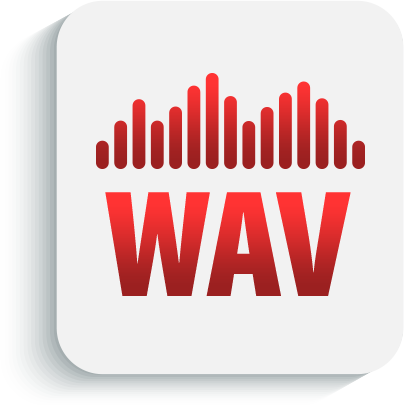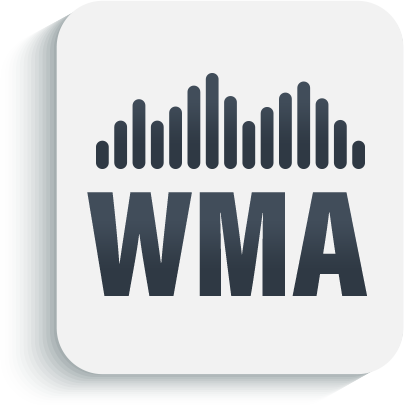Understanding Streaming File Types
For beginner audiophiles diving into the world of streaming music, understanding the different file types is essential. Streaming platforms offer a variety of file formats, each with its own impact on audio quality and file size. This guide aims to demystify streaming file types, explaining their characteristics, pros, and cons. By the end, you’ll be equipped with the knowledge to make informed decisions when choosing the right file type for your streaming preferences and audio quality expectations.

It can be challenging to get exceptional sound when streaming music. You need a great system that works well together, and streaming quality heavily relies on where the music comes from. Streamers are machines that only understand computer language, and they can't play music on their own. For them to make sound, you need a particular device called a Digital-to-Analog Converter, commonly known as a DAC. Some streamers have this built-in, while others require a separate one. The DAC turns computer music into the kind of music your ears can hear. There's a bit more to it than that, though. You also need to understand the different types of music files to get the best sound possible. That's where we come in! We're here to help you in navigating through all these intricacies and ensuring an enhanced music streaming experience.
The Essential Formats
When you listen to music online or on a CD, it goes through a particular computer program called a codec. The codec helps make the music sound and takes up less space on your device. However, different codecs can make the music sound different, so it's essential to know which one is being used. There are three types of audio files you should know about lossy, lossless, and uncompressed. Knowing these types can help you pick the best way to listen to your music.
Lossy
Lossy is probably the file type you encounter most often. These audio files are compressed to the smallest possible size, making them easy to share and transfer. Due to their small size, digital streaming services often use lossy files. However, the compression process will result in some loss of audio data, hence the name. Even the slightest amount of lost data can affect the quality of audio and no more is this noticed in Hi-Fi gear. While lossy files are convenient for sharing and every-day streaming, they may not be the best option for audiophiles.
Lossless
Regarding audio quality, the term "lossless" refers to the best possible audio quality you can get. Lossless files are known for preserving the original audio data's integrity while keeping the file size relatively small. This means you won't lose any audio information during compression, which results in a better audio experience overall.
It's worth noting that almost every digital-to-analog converter (DAC) on the market today supports using lossless files. This means you can enjoy the best audio quality possible without worrying about compatibility issues.
In fact, some of the most popular streaming services, like Apple Music, have started offering lossless file options, which is great news for music enthusiasts who want to enjoy the highest quality audio possible. By opting for lossless files, you can enjoy your favorite tracks in their full glory and appreciate all the nuances that make each song unique. So, if you're a true audiophile, you may want to consider making the switch to lossless files to take your listening experience to the next level.
“It's worth noting that almost every digital-to-analog converter (DAC) on the market today supports using lossless files.”
Uncompressed
Finally, when it comes to audio files, there are different types of formats available. Uncompressed files, usually in WAV format, are considered the gold audiophile standard. These files are a true representation of the original recording, with no data compressed or lost. The advantage of uncompressed files is that they provide a much higher sound quality, allowing you to hear every detail as the artist and sound engineers intended. However, it is important to note that these files can also take up a lot of space on your device or computer. If storage space concerns you, other file formats offer a balance between sound quality and file size. For instance, compressed files in MP3 format are popular, but they do not offer the same level of sound quality as uncompressed files.
The Essential File Types
Advanced Audio Coding (AAC):
Advanced Audio Coding, or AAC for short, is a file format that is often overlooked due to its lack of popularity. However, despite this, AAC files are actually quite capable. Although they use lossy compression, meaning they do not maintain the same level of audio quality as lossless file formats, AAC files are still more than adequate for most purposes. In fact, some experts even argue that AAC files contain slightly more information than MP3.

Perhaps one of the reasons why AAC files are not as widely used as some other file types is that they can be more difficult to play on certain devices. For example, some older music players may not support AAC files, which can cause frustration for users who want to listen to their favorite tunes on these devices. However, despite these challenges, it is worth noting that gaming systems and mobile devices commonly use AAC files.
In addition to this, AAC files offer several advantages that make them an attractive option for users looking for a versatile and high-quality file format. For example, they are often smaller than other files, which can benefit users with limited storage space on their devices. To play AAC files, check your DAC’s specifications as those will usually detail which files the device can support.
Audio Interchange File Formats (AIFF):
AIFF files, which stands for Audio Interchange File Formats, are an excellent choice for audio enthusiasts seeking the best sound quality. These file types are considered super versatile and can be played on almost any media player, whether an Apple or Windows device. One of the best things about AIFF files is that they are uncompressed, meaning that they preserve all the precious data of the original recording.

This is particularly important for those using Hi-Fi systems, where every detail and nuance of the music can be fully appreciated. Additionally, AIFF files offer a wide range of functionality, making them an ideal choice for both personal and professional use. So if you're looking for a file format that offers high-quality sound and flexibility, AIFF files are definitely worth considering.
Apple Lossless Audio Codec (ALAC):
Apple Lossless Audio Codec, or ALAC for short, is an audio codec developed by Apple Inc. This codec is designed to provide the ultimate listening experience for Apple Music users by offering lossless audio files. This means that all ALAC files maintain the original quality of the source recording, and the sound quality is significantly better than any lossy files. Not only does ALAC maintain high sound quality, but it is also a highly efficient codec that doesn't require much space on your device. This makes it a great choice for music enthusiasts who want to enjoy high-quality music without taking up too much storage space. Additionally, ALAC is compatible with various devices and platforms, making it a versatile option for music lovers.

Free Lossless Audio Codec (FLAC):
Free Lossless Audio Codec (FLAC) is a digital audio format that uses lossless compression to reduce file size without sacrificing quality. FLAC can compress audio data without losing any original information, which means that it can offer true CD-quality sound. This makes it an ideal format for audiophiles who want to enjoy high-quality music without sacrificing storage space.

Although not all devices support FLAC files, they can be easily played on most modern computers and smartphones. However, if you want to share FLAC files with others, it might require downloading specific programs or codecs to ensure compatibility. Despite this hurdle, FLAC can be a fantastic option for those looking for an optimal space and performance ratio, as it offers superior sound quality compared to other lossy formats like MP3 or AAC.
In addition, FLAC files can also support embedded metadata, including album artwork, song titles, and even lyrics. This allows for a more immersive listening experience and makes organizing and searching for your music collection easier. Furthermore, FLAC files can be easily converted to other audio formats without losing original quality, which means you can enjoy your music on virtually any device or platform.
MPEG Audio Layer 3 (MP3):
MP3 is one of the most popular audio file formats in the world. It became famous due to its use in MP3 Players, greatly contributing to its widespread popularity. MP3 files, or MPEG audio layer 3 files, are designed to allow for quick and easy music and other audio content sharing. While MP3 files are known for being lossy, meaning they don't offer the highest audio quality, they are incredibly compact and versatile and can be used or processed by almost every audio device available on the market today.

The popularity of the MP3 format cannot be overstated. It has revolutionized how we listen to music, allowing us to carry thousands of songs in our pockets and making it easy to share music with friends and family across the globe. Furthermore, using MP3 files has paved the way for developing other audio file formats, such as AAC and WMA, which offer even greater compression ratios and improved sound quality.
Despite its widespread use, MP3 technology continues to evolve. Newer versions of the format, such as MP3Pro and MP3HD, offer enhanced sound quality and even greater compression ratios, making it possible to store even more music on your device. As technology advances, it's clear that MP3 will play a significant role in the audio world for years to come.
MPEG 4 (MP4):
While the names are quite similar, there are a number of significant differences between the MP3 and the MP4 formats. While MP3 files are exclusively used for audio, MP4 files can handle both audio and video, making them a more versatile option. Additionally, MP4 files are generally considered to have better quality than MP3 files, although it's important to note that this isn't always the case. MP4 files can also store additional information, such as subtitles and chapter markers, enhancing the viewing experience. Despite these advantages, MP3 files are still widely used and remain popular for those who prioritize smaller file sizes and faster download speeds over audio and video quality.

OGG Vorbis:
OGG Vorbis files are a type of audio format that is not as commonly used as MP3 files. Despite their relative obscurity, they are often considered to be superior to MP3 files in terms of sound quality. It is worth noting, however, that OGG Vorbis files are also a type of lossy file, which means that some of the original sound data is lost during the compression process. Despite this, they are still preferred by some music streaming services like Spotify due to their ability to compress files without sacrificing sound quality. Therefore, it is safe to say that OGG Vorbis files are a viable option for those who value both file size and sound quality.

Waveform Audio File Format (WAV):
Windows Media Audio (WMA) is a file format that is commonly used by Windows devices. It is essentially Microsoft's version of the popular MP3 format. However, what sets WMA files apart from MP3s is their lossless capabilities. While MP3 files use a lossy compression algorithm that sacrifices some audio quality to reduce file size, WMA files can retain the original quality of the audio. This means that with the right gear, you'll be able to hear a noticeable difference in audio quality between MP3s and WMAs.

Windows Media Audio (WMA):
WAV files are uncompressed audio files, meaning that they contain all the original data recorded without any data loss. This results in high audio quality, making them the ideal audiophile choice. WAV files can reproduce a wider range of sounds and tones, offering a more accurate representation of the original recording. However, because they are uncompressed, the file size tends to be larger than compressed audio formats such as MP3 or AAC. This can pose challenges when it comes to sharing the files, given the increased storage requirements and longer upload/download times.

Additionally, WMA files offer other advantages compared to MP3s. They support higher bitrates, meaning they can offer higher-quality audio at the same file size. Moreover, they are compatible with a wider range of devices, not just those running on Windows. However, it is worth noting that some devices may not support WMA files natively, so you may need to convert them to another format first.
The Significance of Digital Audio Files in the Modern Era
In the current age of technology, digital audio files have become an integral part of modern audio systems and devices. Digital audio file formats are necessary for storing, transmitting, and playing back audio content in a variety of settings. Below are the key areas in which digital audio files are commonly used:
One major trend is the rise in digital music libraries, which allow people to store and organize their music collections on computers, smartphones, and portable music players. These libraries rely on digital audio files in various formats, such as MP3, AAC, FLAC, WAV, and ALAC. Of course, streaming services are now another popular way to access music in the digital age. These online platforms give users access to a vast library of songs without physically owning them.
For those who prefer to purchase music, online music stores offer digital audio files that can be downloaded and stored on devices. The format options available may include MP3, AAC, FLAC, ALAC, and others. Digital audio players and portable music players require digital audio file formats to play music. The players support a range of formats to cater to different user preferences. Beyond that, computer audio interfaces also rely on digital audio file formats to transmit sound data. These formats allow for high-quality playback and recording through audio interfaces. Also, in professional music production, digital audio workstations (DAWs) use digital audio file formats to store and manipulate audio recordings, samples, and virtual instruments.

Digital audio formats are also used to encode and transmit the sound component for video content, including audio. Streaming services like YouTube and Netflix are examples of this. Radio broadcasts utilize this technology for efficient transmission and better sound quality than analog broadcasts. In the film and gaming industries, sound effects and Foley artists rely on digital audio file formats to store and access various sounds and audio elements.
Finally, digital audio formats are the primary means of distributing audiobooks and podcasts, making them accessible to listeners through various platforms and devices.
The transition to digital audio file formats has transformed how we consume, store, and produce audio content, providing enhanced convenience, accessibility, and improved sound quality in numerous audio-related applications. The use of digital audio files is expected to continue to grow in the future as technology advances and new applications emerge.
Getting to Know Your Audio Files
If you’re planning on investing in a Hi-Fi streamer or just interested in what streaming offers, understanding how files can impact your sound is critical.
Having a good understanding of files not only helps you determine what streamers you need to play the files you own or plan to own, but it also enables you to make informed decisions about the quality of the sound you want to achieve. Pay special attention to compatibility between your files and your DAC or streamer is important, as not every device is compatible with every file type.
Therefore, investing time in learning about different file formats and their impact on sound quality can greatly enhance your listening experience and help you make the best decisions when it comes to choosing the right Hi-Fi streamer for your needs.

Ear training
One effective way to improve your ability to evaluate audio equipment and files is by training your ears to identify different audio characteristics. By doing so, you can gain a deeper understanding of how different frequencies and dynamics affect the overall sound and learn to recognize the unique soundstage of each recording. In order to develop a critical ear, it is important to listen to a wide variety of music and pay close attention to the details of each track. You can also experiment with different types of audio gear and settings to better understand how different equipment can affect the sound. Additionally, identifying and describing audio characteristics can be valuable in many fields, including music production, sound engineering, and audio journalism. So, take the time to train your ears and improve your ability to evaluate and appreciate audio nuances.

